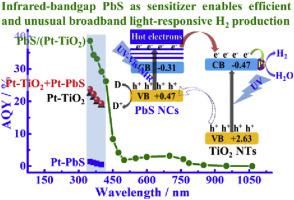当前位置:
X-MOL 学术
›
Mater. Today Chem.
›
论文详情
Our official English website, www.x-mol.net, welcomes your
feedback! (Note: you will need to create a separate account there.)
Fabrication of PbS nanocrystal-sensitized ultrafine TiO2 nanotubes for efficient and unusual broadband-light-driven hydrogen production
Materials Today Chemistry ( IF 6.7 ) Pub Date : 2020-09-01 , DOI: 10.1016/j.mtchem.2020.100310 J. Wang , S. Chen , D. Liu , C. Chen , R. Li , T. Peng
Materials Today Chemistry ( IF 6.7 ) Pub Date : 2020-09-01 , DOI: 10.1016/j.mtchem.2020.100310 J. Wang , S. Chen , D. Liu , C. Chen , R. Li , T. Peng

|
Abstract It is highly desired to maximize the use of solar light by developing broadband-light-responsive H2 production system in the field of photocatalysis. Herein, a novel PbS/(Pt–TiO2) nanocomposite with efficient and unusual broadband-light-driven H2 production feature is constructed by using infrared-bandgap PbS nanocrystals as sensitizer of Pt-loaded ultrafine anatase TiO2 nanotubes (Pt–TiO2). After optimizing the component ratio, the resultant PbS/(Pt–TiO2) nanocomposite delivers a H2 production activity of 813 and 186 μmol h−1 under ultraviolet (UV)-visible (Vis)-near-infrared (NIR) and Vis-NIR light irradiation, respectively. Moreover, an apparent quantum yield of 38.6%, 26.2%, 2.43%, 3.21%, 2.17%, 0.36%, 0.11% and 0.01% can be attained from the PbS/(Pt–TiO2) nanocomposite illuminated at 350, 420, 550, 700, 760, 850, 950 and 1064 nm monochromatic light, respectively. The intimate interfacial contacts in the PbS nanocrystals decorated ultrafine TiO2 nanotubes, which serve as the support and electron acceptor of PbS nanocrystals, can effectively promote the photoexcited hot electrons transferring from PbS nanocrystals to TiO2 nanotubes before the thermalization losses, and thus causing the efficient Vis-NIR-light-responsive H2 production activity of the PbS/(Pt–TiO2) nanocomposite. These results provide an intriguing application of infrared-bandgap materials to exploit the low-energy photons of the solar light for constructing efficient and unusual broadband-responsive H2 production system.
中文翻译:

制备 PbS 纳米晶敏化超细 TiO2 纳米管,用于高效且不寻常的宽带光驱动制氢
摘要 在光催化领域开发宽带光响应制氢系统以最大限度地利用太阳光是人们迫切需要的。在此,通过使用红外带隙 PbS 纳米晶体作为载铂超细锐钛矿 TiO2 纳米管 (Pt-TiO2) 的敏化剂,构建了一种新型 PbS/(Pt-TiO2) 纳米复合材料,该复合材料具有高效且不寻常的宽带光驱动 H2 生产特性。优化组分比后,所得的 PbS/(Pt-TiO2) 纳米复合材料在紫外 (UV)-可见光 (Vis)-近红外 (NIR) 和 Vis-NIR 下提供 813 和 186 μmol h-1 的 H2 生产活性光照射,分别。此外,PbS/(Pt-TiO2) 纳米复合材料在 350、45020、5020 光照下可以获得 38.6%、26.2%、2.43%、3.21%、2.17%、0.36%、0.11% 和 0.01% 的表观量子产率, 700, 760, 850, 分别为 950 和 1064 nm 单色光。PbS 纳米晶体中的紧密界面接触装饰了超细 TiO2 纳米管,作为 PbS 纳米晶体的载体和电子受体,可以在热化损失之前有效地促进光激发热电子从 PbS 纳米晶体转移到 TiO2 纳米管,从而导致有效的 Vis -PbS/(Pt-TiO2) 纳米复合材料的近红外光响应制氢活性。这些结果为红外带隙材料提供了一种有趣的应用,可以利用太阳光的低能光子构建高效且不寻常的宽带响应 H2 生产系统。作为 PbS 纳米晶体的载体和电子受体,可以有效地促进光激发热电子在热化损失之前从 PbS 纳米晶体转移到 TiO2 纳米管,从而导致 PbS/ (Pt-TiO2) 纳米复合材料。这些结果为红外带隙材料提供了一种有趣的应用,可以利用太阳光的低能光子构建高效且不寻常的宽带响应 H2 生产系统。作为 PbS 纳米晶体的载体和电子受体,可以有效地促进光激发热电子在热化损失之前从 PbS 纳米晶体转移到 TiO2 纳米管,从而导致 PbS/ (Pt-TiO2) 纳米复合材料。这些结果为红外带隙材料提供了一种有趣的应用,可以利用太阳光的低能光子构建高效且不寻常的宽带响应 H2 生产系统。
更新日期:2020-09-01
中文翻译:

制备 PbS 纳米晶敏化超细 TiO2 纳米管,用于高效且不寻常的宽带光驱动制氢
摘要 在光催化领域开发宽带光响应制氢系统以最大限度地利用太阳光是人们迫切需要的。在此,通过使用红外带隙 PbS 纳米晶体作为载铂超细锐钛矿 TiO2 纳米管 (Pt-TiO2) 的敏化剂,构建了一种新型 PbS/(Pt-TiO2) 纳米复合材料,该复合材料具有高效且不寻常的宽带光驱动 H2 生产特性。优化组分比后,所得的 PbS/(Pt-TiO2) 纳米复合材料在紫外 (UV)-可见光 (Vis)-近红外 (NIR) 和 Vis-NIR 下提供 813 和 186 μmol h-1 的 H2 生产活性光照射,分别。此外,PbS/(Pt-TiO2) 纳米复合材料在 350、45020、5020 光照下可以获得 38.6%、26.2%、2.43%、3.21%、2.17%、0.36%、0.11% 和 0.01% 的表观量子产率, 700, 760, 850, 分别为 950 和 1064 nm 单色光。PbS 纳米晶体中的紧密界面接触装饰了超细 TiO2 纳米管,作为 PbS 纳米晶体的载体和电子受体,可以在热化损失之前有效地促进光激发热电子从 PbS 纳米晶体转移到 TiO2 纳米管,从而导致有效的 Vis -PbS/(Pt-TiO2) 纳米复合材料的近红外光响应制氢活性。这些结果为红外带隙材料提供了一种有趣的应用,可以利用太阳光的低能光子构建高效且不寻常的宽带响应 H2 生产系统。作为 PbS 纳米晶体的载体和电子受体,可以有效地促进光激发热电子在热化损失之前从 PbS 纳米晶体转移到 TiO2 纳米管,从而导致 PbS/ (Pt-TiO2) 纳米复合材料。这些结果为红外带隙材料提供了一种有趣的应用,可以利用太阳光的低能光子构建高效且不寻常的宽带响应 H2 生产系统。作为 PbS 纳米晶体的载体和电子受体,可以有效地促进光激发热电子在热化损失之前从 PbS 纳米晶体转移到 TiO2 纳米管,从而导致 PbS/ (Pt-TiO2) 纳米复合材料。这些结果为红外带隙材料提供了一种有趣的应用,可以利用太阳光的低能光子构建高效且不寻常的宽带响应 H2 生产系统。











































 京公网安备 11010802027423号
京公网安备 11010802027423号